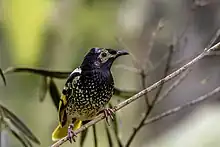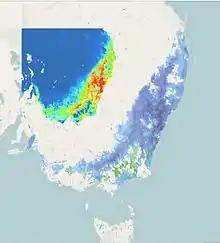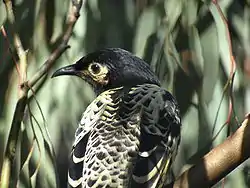Regent honeyeater
The regent honeyeater (Anthochaera phrygia) is a critically endangered bird endemic to southeastern Australia. It is commonly considered a flagship species within its range, with the efforts going into its conservation having positive effects on many other species that share its habitat. Recent genetic research suggests it is closely related to the wattlebirds.
| Regent honeyeater | |
|---|---|
 | |
| Scientific classification | |
| Domain: | Eukaryota |
| Kingdom: | Animalia |
| Phylum: | Chordata |
| Clade: | Dinosauria |
| Class: | Aves |
| Order: | Passeriformes |
| Family: | Meliphagidae |
| Genus: | Anthochaera |
| Species: | A. phrygia |
| Binomial name | |
| Anthochaera phrygia (Shaw, 1794) | |
 | |
| Distribution of the regent honeyeater, see file for more details. | |
| Synonyms | |
| |
Taxonomy
First described by the English naturalist George Shaw in 1794, the regent honeyeater was moved to Anthochaera in 1827 by the naturalists Nicholas Aylward Vigors and Thomas Horsfield.[2] It was known as Xanthomyza phrygia for many years, the genus erected by William John Swainson in 1837. DNA analysis shows that its ancestry is in fact nested within the wattlebird genus Anthochaera. The ancestor of the regent honeyeater split from a lineage that gave rise to the red and yellow wattlebirds. The little and western wattlebirds arose from another lineage that diverged earlier.[3] The generic name Anthochaera derives from the Ancient Greek anthos 'flower, bloom' and khairō 'enjoy'; the specific epithet phrygia derives from Latin phrygius, referring to the people of Phrygia who were skilled in embroidery with gold.[4]
Description
The neck and head are glossy black. The breast is covered with contrasting pale yellow speckles, and the feathers in the tail and wings are black and bright yellow.
Diet
It feeds primarily on nectar from eucalyptus and mistletoe species, and to a lesser extent on insects and their honeydew. It also feeds on both native and cultivated fruit.[5]
Breeding
Breeding mostly occurs from August to January, during the southern spring and summer. The breeding season appears to correspond with the flowering of key eucalyptus and mistletoe species. Two or three eggs are laid in a cup-shaped nest.[5] Nest success, and productivity of successful nests, has been found to be low in this species, with nest surveillance revealing high predation by a range of bird and arboreal mammal species. There is also a male bias to the adult sex ratio, with an estimated 1.18 males per female.[6]
Distribution


The regent honeyeater was once common in wooded areas of eastern Australia, especially along the inland slopes of the Great Dividing Range. It once could be found as far west as Adelaide, but is now gone from South Australia and western Victoria.[7] As of June 2020 their range covers from north-east Victoria up to around the Sunshine Coast, Queensland,[8] but the population is now scattered. Most sightings are from a few sites in north-eastern Victoria, along the western slopes of the Great Dividing Range in New South Wales and the central coast of New South Wales.[9] In 1999 the three main breeding areas were the Bundarra-Barraba area and Capertee Valley of New South Wales, and north-eastern Victoria.[10]
Most of these breeding sites were affected by the devastating 2019–2020 Australian bushfires, which will likely have a very negative effect on the already-small wild population.[11]
Important Bird Areas
BirdLife International identified the following sites as being important for regent honeyeaters in 2011:[12]
- Queensland
- New South Wales
- Brisbane Water
- Bundarra-Barraba
- Capertee Valley
- Greater Blue Mountains
- Hastings-Macleay
- Hunter Valley
- Lake Macquarie
- Mudgee-Wollar
- Richmond Woodlands
- Tuggerah
- Victoria
In July and August 2018, pairs of birds were seen at three sites in south-eastern Queensland. A spokesman for BirdLife Australia said this was indicative of the current drought conditions in northern New South Wales placing pressure on the birds to find more favourable food sources.[13]
Conservation status
The regent honeyeater is listed as critically endangered on the IUCN Red List,[1] and was listed as endangered under both Australia's Environment Protection and Biodiversity Conservation Act 1999 (EPBC Act)and Queensland's Nature Conservation Act 1992.[14] The Action Plan for Australian Birds 2010, compiled by researchers from Charles Darwin University, and published in October 2011 by the CSIRO, added the regent honeyeater to the "critically endangered" list, giving habitat loss as the major threat.[15]
The bird was upgraded from endangered to critically endangered nationally (under the EPBC Act) on 9 July 2015. Each state has applied its own rating to the bird under state legislation, varying from "threatened" (Victoria) to "critically endangered" (NSW).[16][14]
The Commonwealth Department of the Environment formulated a National Recovery Plan for the regent honeyeater in April 2016.[17] The 2019-2020 fires would likely push the species closer to extinction, with only about 250 of the species left in the wild at that time.[11]
A 2018 study ranked it seventh in a list of Australian birds most likely to go extinct.[18]
A genetic study published in 2019 used hybridization RAD (hyRAD) technique on recent and museum samples from wild birds ranging over a 100-year time frame sampled throughout the historical and contemporary range, and assessing the impact of the decline on recent and current population size, structure and genetic diversity.[19] The museum sampling showed that population structure in regent honeyeaters was historically low, which remains the case despite severe fragmentation of their breeding range. Extinction may occur in this nomadic species before a detectable genomic impact of small population size is realised.
A March 2021 research study warned that the rapid decline in the rare songbird means its young are struggling to learn mating calls as adults disappear, which could further strain conservation efforts and avoid extinction.[20] The complexity of their songs have declined, and 12 per cent of males were found to be singing other species' songs,[21] including the currawong and eastern rosella. According to one of the authors of the study, this loss of song can reduced the birds' ability to find a mate, and, if they do, the female is less likely to lay an egg.[22]
Conservation efforts
A captive breeding program on a private property in the Hunter Valley released 20 birds – 11 female and 9 male – into the wild in June 2020. In 2012, birds had been released in the same area from a Taronga Zoo breeding program. Much work was being done to ensure that the birds had sources of food, and most of the birds were fitted with tiny radio transmitters so that their movements could be tracked. With about 13 wild birds at the site, it was hoped that those released from captivity would breed with the wild ones and increase the population and diversity. This was the first release of regent honeyeaters since a similar event in north-eastern Victoria.[8] In August 2020, one of the banded birds was spotted and photographed at a Hunter Valley home, for the first time since her release two months earlier. Another of the birds was found and led the conservationists to a new flock of wild regent honeyeaters near Broke, about 30 kilometres (19 mi) from the release site, of which they had not previously been aware.[23]
References
Citations
- BirdLife International (2018). "Anthochaera phrygia". IUCN Red List of Threatened Species. 2018: e.T22704415A130992272. doi:10.2305/IUCN.UK.2018-2.RLTS.T22704415A130992272.en. Retrieved 12 November 2021.
- Vigors & Horsfield 1827, pp. 320-321.
- Driskell, Amy C.; Christidis, Les (2004). "Phylogeny and Evolution of the Australo-Papuan Honeyeaters (Passeriformes, Meliphagidae)". Molecular Phylogenetics and Evolution. 31 (3): 943–60. doi:10.1016/j.ympev.2003.10.017. PMID 15120392.
- Jobling, James A. (2010). "Helm Dictionary of Scientific Bird-names". Retrieved 24 April 2020.
- "BirdLife Australia:Regent Honeyeater". birdlife.org.au. Retrieved 16 August 2019.
- Crates, R.; Rayner, L.; Stojanovic, D.; Webb, M.; Terauds, A.; Heinsohn, R. (2019). "Contemporary breeding biology of critically endangered Regent Honeyeaters: implications for conservation". Ibis. 161 (3): 521–532. doi:10.1111/ibi.12659.
- Siossian, Emma (28 March 2019). "Conservationists push to save critically endangered regent honeyeater's only known breeding site from development". ABC Mid North Coast. Retrieved 30 March 2019.
- Siossian, Emma (23 June 2020). "Captive-bred regent honeyeaters successfully released in Hunter Valley, giving new hope for critically endangered species". ABC News. Australian Broadcasting Corporation. Retrieved 24 June 2020.
- "Regent Honeyeater Anthochaera phrygia". Birdlife International - Datazone. 2020.
- Menkhorst, Peter; Schedvin, Natasha & Geering, David (May 1999). "Regent Honeyeater (Xanthomyza phrygia) Recovery Plan 1999-2003". Department of the Environment, Water, Heritage and the Arts, Australia. Archived from the original on 8 November 2016. Retrieved 8 November 2016.
- BirdLife International. "Bushfires update: a message from BirdLife Australia". BirdLife. Retrieved 18 January 2020.
- BirdLife International (2011). Important Bird Areas. Downloaded from http://www.birdlife.org on 2012-01-02.
- Regent honeyeater 'one step from extinction' sighted in Queensland, Shelley Lloyd, ABC News Online, 2018-08-08
- Dept of the Environment, Commonwealth of Australia. "Anthochaera phrygia — Regent Honeyeater". www.environment.gov.au. Retrieved 16 August 2019.
- Garnett, Stephen; Szabo, Judit; Dutson, Guy (2011). The Action Plan for Australian Birds 2010. Collingwood, Vic: CSIRO. ISBN 978-0-643-10368-9.
- "Regent Honeyeater". BirdLife. Retrieved 24 June 2020.
- "National Recovery Plan for the Regent Honeyeater (Anthochaera phrygia)" (PDF). Department of the Environment. April 2016. Retrieved 16 August 2019.
- Geyle, Hayley M.; Woinarski, John C. Z.; et al. (20 April 2018). "Quantifying extinction risk and forecasting the number of impending Australian bird and mammal extinctions". Pacific Conservation Biology. 24 (2): 157–167. doi:10.1071/PC18006. ISSN 2204-4604. Retrieved 11 July 2022. PDF
- Crates, Ross; Olah, George; Adamski, Marcin; Aitken, Nicola; Banks, Sam; Ingwersen, Dean; Ranjard, Louis; Rayner, Laura; Stojanovic, Dejan; Suchan, Tomasz; von Takach Dukai, Brenton; Heinsohn, Robert (2019). Russello, Michael A. (ed.). "Genomic impact of severe population decline in a nomadic songbird". PLOS ONE. 14 (10): e0223953. doi:10.1371/journal.pone.0223953. ISSN 1932-6203. PMC 6812763. PMID 31647830.
- "Endangered Australian songbird 'losing its song'". CTVNews. 17 March 2021. Retrieved 19 March 2021.
- Crates, Ross; Langmore, Naomi; et al. (17 March 2021). "Loss of vocal culture and fitness costs in a critically endangered songbird". Proceedings of the Royal Society B: Biological Sciences. The Royal Society. 288 (1947). doi:10.1098/rspb.2021.0225. ISSN 0962-8452. PMC 8059949. PMID 33726592.
- Siossian, Emma (17 March 2021). "Regent honeyeaters are so rare that young birds aren't learning their own song". ABC News. Australian Broadcasting Corporation. Retrieved 22 March 2021.
- Siossian, Emma (22 August 2020). "Released captive-bred regent honeyeater leads conservationists to wild Hunter Valley flock". ABC News. Australian Broadcasting Corporation. Retrieved 23 August 2020.
Cited texts
- Vigors, N.A.; Horsfield, T. (1827). "A description of the Australian birds in the collection of the Linnean Society; with an attempt at arranging them according to their natural affinities (Part 1)". Transactions of the Linnean Society of London. 15 (1): 170–331. doi:10.1111/j.1095-8339.1826.tb00115.x. The title page of the issue has the year 1826.
External links
- Recordings of regent honeyeater from Cornell Laboratory of Ornithology's Macaulay library
- Recordings of regent honeyeater from Graeme Chapman's sound library
- Recordings of regent honeyeater from Xeno-canto sound archive
